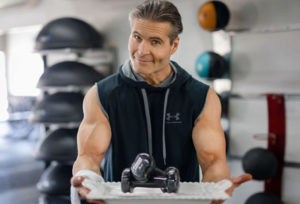Pickleball is one of the fastest-growing sports in the U.S., especially in San Diego, where its popularity continues to soar. Combining elements of tennis, badminton, and table tennis, pickleball is an accessible and fun way to stay active. However, like any sport, it carries inherent risks of injury, especially for players who aren’t physically prepared for the quick movements the game demands. Whether you’re a seasoned player or just starting out, it’s essential to understand the dangers and risks of pickleball—and how to prevent them.
As a personal trainer in San Diego, I work with many clients who play pickleball and have seen firsthand how important it is to be proactive about injury prevention. In this article, we’ll explore the common injuries in pickleball, key statistics, and injury prevention tips to help you enjoy the game safely.
The Growing Popularity of Pickleball in San Diego
Pickleball’s popularity has surged across the United States, and it’s no different here in San Diego. With our beautiful weather and outdoor lifestyle, pickleball is the perfect sport to stay active while enjoying the sunshine. The Sport & Fitness Industry Association (SFIA) reports that over 4.8 million people play pickleball in the U.S., and this number is rising every year. Pickleball is especially popular among older adults because it’s easier on the joints compared to high-impact sports like tennis, making it a great option for active seniors.
However, even though pickleball is considered a low-impact sport, it’s not without risks. Let’s take a closer look at the most common pickleball injuries and how you can prevent them.
Common Pickleball Injuries
While pickleball is often promoted as a sport that’s easy on the body, it’s still possible to sustain injuries. The game requires quick movements, sudden stops, and frequent lateral shifts, which can put strain on the body if you’re not properly conditioned. Here are some of the most common injuries in pickleball:
-
Sprains and Strains: Sudden movements and quick changes in direction are a recipe for sprains and strains, particularly in the ankle, knee, or shoulder.
-
Ankle and Knee Injuries: Pivoting and rapid lateral movements can lead to ankle sprains or knee injuries. Twisting your knee or rolling an ankle during a fast-paced rally can result in injury.
-
Rotator Cuff Injuries: The repetitive overhead motions used in pickleball—especially while serving or executing power shots—can put a strain on your shoulder joint, leading to rotator cuff injuries.
-
Elbow Injuries: “Pickleball elbow,” a form of tendinitis, is a common injury in players who use improper technique or overuse their arms during the game. Overhead serves or constant backhand shots can cause this issue.
-
Back Injuries: The constant bending, twisting, and reaching in pickleball can strain the lower back, especially if you don’t maintain proper posture or warm up effectively or you sit a lot or workout a lot before playing. One scenario your back is not prepared and the other it is overworked.
-
Head Injuries: Though less common, falls or collisions with the net post or other players can result in head injuries. Always be mindful of your surroundings when playing pickleball.
Injury Statistics for Pickleball Players
While pickleball is relatively new compared to other sports, there is a growing body of research on injury rates. Several studies and reports have sought to quantify the risks of playing pickleball. A survey conducted by the Pickleball Forum in 2022 revealed that about 25% of respondents had sustained some form of injury while playing. Among these injuries, the most common were ankle sprains, knee problems, and shoulder injuries.
-
A study published in the British Journal of Sports Medicine in 2018 looked at injuries in pickleball players and found that 13.4% of pickleball players suffered an injury over a one-year period. The majority of these injuries were musculoskeletal, with sprains and strains being the most common.
-
A 2021 study from the National Electronic Injury Surveillance System (NEISS) found that pickleball-related injuries have increased by 50% from 2017 to 2021, with many of the injuries occurring in players aged 65 and older. This age group is particularly vulnerable to falls, bone fractures, and strains.
-
In a survey of over 1,000 pickleball players conducted by the Pickleball Forum in 2022, nearly 25% of respondents reported having experienced some form of injury while playing. Among those who were injured, the majority cited ankle sprains, knee issues, and shoulder injuries as the most common problems.
-
A study from the American Journal of Sports Medicine (2023) found that pickleball players in their 50s and 60s experienced a higher rate of injuries compared to younger players. This highlights the need for older players to be especially cautious and proactive about injury prevention.
Risk Factors for Pickleball Injuries
Several factors contribute to the likelihood of injury in pickleball. As a personal trainer in San Diego, I emphasize the following risk factors to my clients:
-
Age and Fitness Level: Older players or those who aren’t physically fit may be at greater risk of injury. If you haven’t been active for a while or have a history of joint issues, it’s important to work on strengthening your muscles and improving flexibility before playing pickleball.
-
Inadequate Warm-Up: Failing to warm up properly can leave your muscles and joints unprepared for the rapid movements and sudden stops in pickleball. A good warm-up increases blood flow to the muscles and helps prevent strains.
-
Court Conditions: The surface of the court matters. Cracks or uneven surfaces can cause slips and falls. Always check the condition of the court before you start your game to minimize the risk of injury.
-
Improper Technique: Using improper form, especially when serving or hitting powerful shots, can lead to injury. Overuse or poor mechanics place unnecessary stress on your joints and muscles.
-
Playing Beyond Your Limits: Whether you’re new to the game or a seasoned player, playing too aggressively or pushing your body too hard can increase the likelihood of injury. Take breaks, listen to your body, and rest when needed.
-
Dehydration: Often, we assume we’re properly hydrated, but that’s not always the case. When muscles are dehydrated, they can’t contract or relax properly, leading to weakness, cramps, fatigue, and soreness. This happens because dehydration impairs blood flow and disrupts electrolyte balance, both of which are vital for muscle function. As a result, you may experience painful muscle spasms in areas like the quadratus lumborum, multifidi, or spinal erectors, which can become debilitating.
-
Physical Weakness or Imbalances: Let’s face it—our bodies don’t function the same way as we age. Along with weight gain, the wear and tear on joints, particularly in the lower back, ankles, shoulders, and knees, makes us more vulnerable to injuries.
Injury Prevention Tips for Pickleball Players
As a personal trainer in San Diego, my goal is to help you prevent injuries and enjoy pickleball safely. Here are some injury prevention tips to keep in mind:
-
Warm Up and Stretch: A proper warm-up is essential to prepare your body for the physical demands of pickleball. Focus on stretching your shoulders, hips, knees, and ankles. Dynamic stretches like leg swings and arm circles can help improve your range of motion and flexibility.
-
Strengthen Your Core and Legs: A strong core and legs provide stability and support, reducing the risk of injury. Incorporating exercises like squats, lunges, and planks into your fitness routine can help you build the strength needed for quick lateral movements and sudden stops.
-
Use Proper Footwear: Wear shoes designed for court sports, which offer the right combination of support, cushioning, and grip. Proper footwear helps prevent ankle sprains and knee injuries by providing the necessary stability on the court.
-
Focus on Technique: Learning the proper form for serving, hitting shots, and moving around the court can reduce the stress on your joints and muscles. If you’re unsure about your form, consider working with a coach or trainer to refine your technique.
-
Play at Your Own Pace: Know your limits and don’t overexert yourself. If you start to feel fatigued or experience pain, take a break. Pushing yourself too hard can lead to injury.
-
Hydrate and Rest: Staying hydrated is essential for muscle function and recovery. Additionally, rest is crucial to prevent overuse injuries. Avoid playing for extended periods without taking breaks.
Conclusion: Stay Safe and Enjoy Pickleball in San Diego
Pickleball is an exciting and accessible sport that can be enjoyed by players of all ages and fitness levels. However, like any physical activity, it comes with the risk of injury. By staying mindful of the potential risks, warming up properly, using proper technique, and following injury prevention tips, you can reduce your chances of injury and enjoy pickleball safely.
If you’re in San Diego and looking for personalized guidance on how to improve your fitness, prevent injuries, and take your pickleball game to the next level, reach out to a certified personal trainer. Together, we can help you build the strength, flexibility, and endurance needed to play pickleball with confidence and enjoy the sport for years to come!
Optimize Your body with Personal Training:
Are you feeling weak, tired and just not yourself? Are watching your health & Fitness slip away? Maybe it’s time to enhance your Strength, Agility, Stability & Flexibility through exercises. Contact us today to schedule a consultation with John Turk, San Diego’s top personal trainer for aging professionals wanting to get their body back. Whatever your fitness goals are, we’ll create a customized plan that works for you.
Call 858-877-1370
Visit us at www.PersonalTrainerSanDiego.com to Get Started








